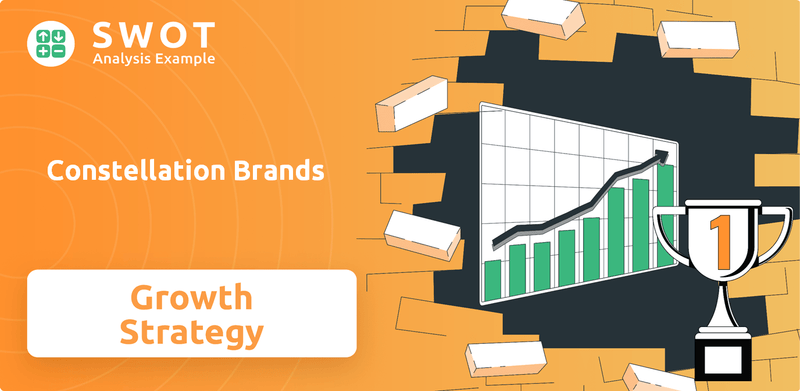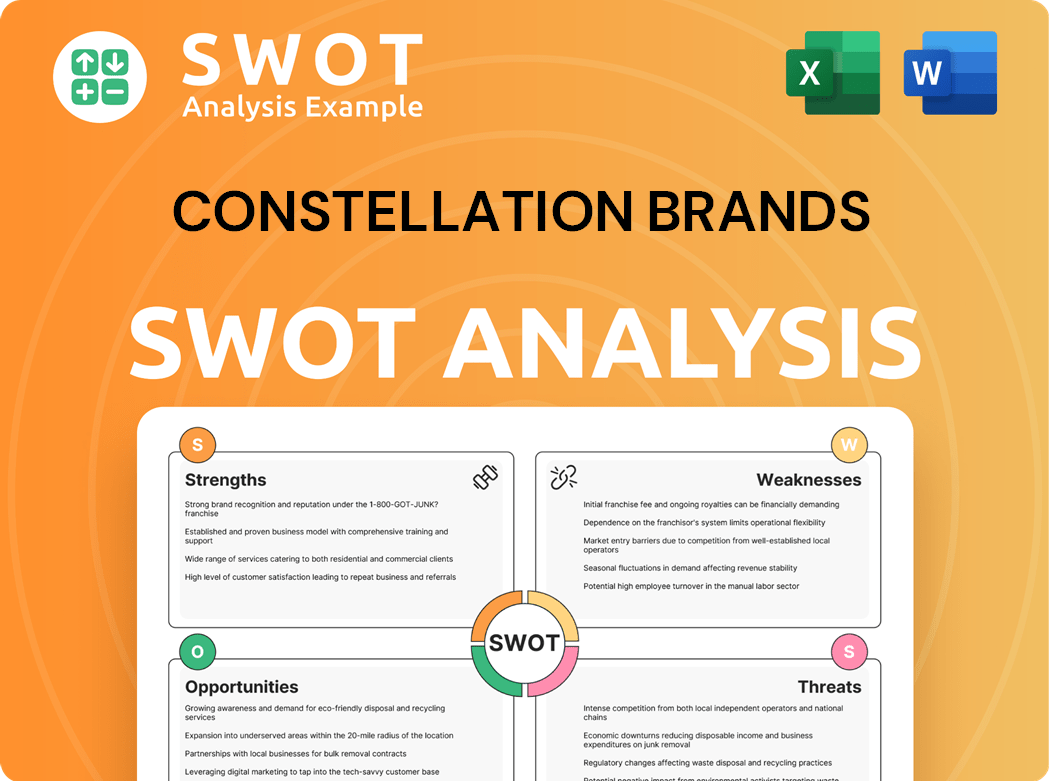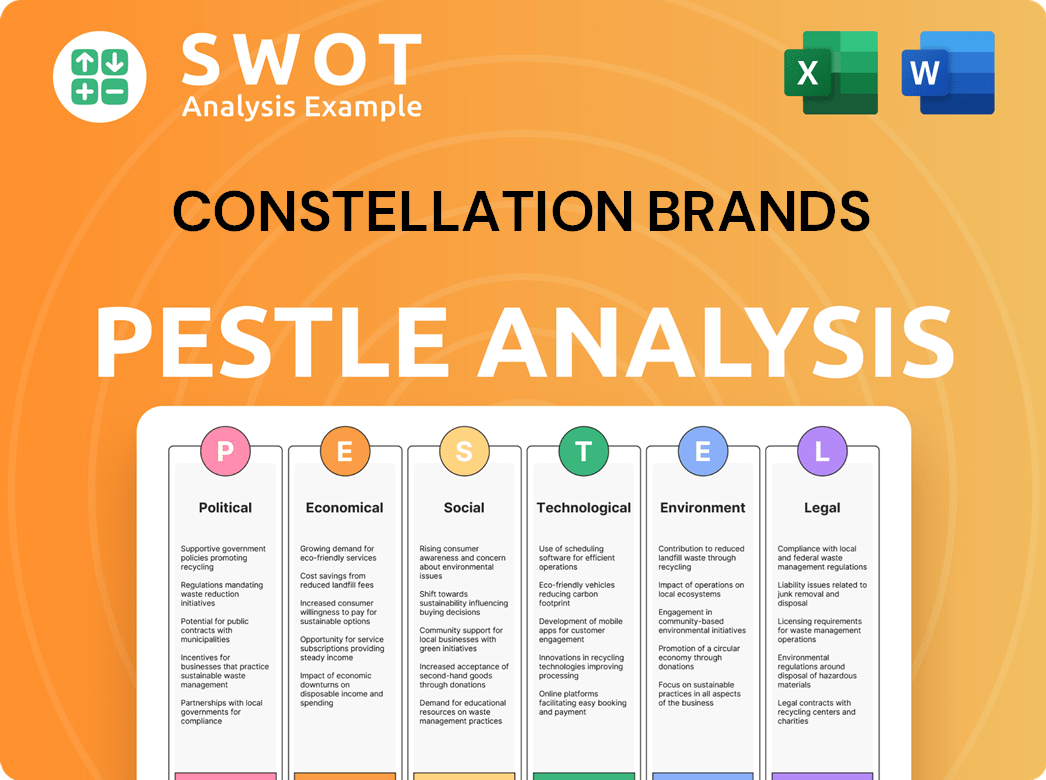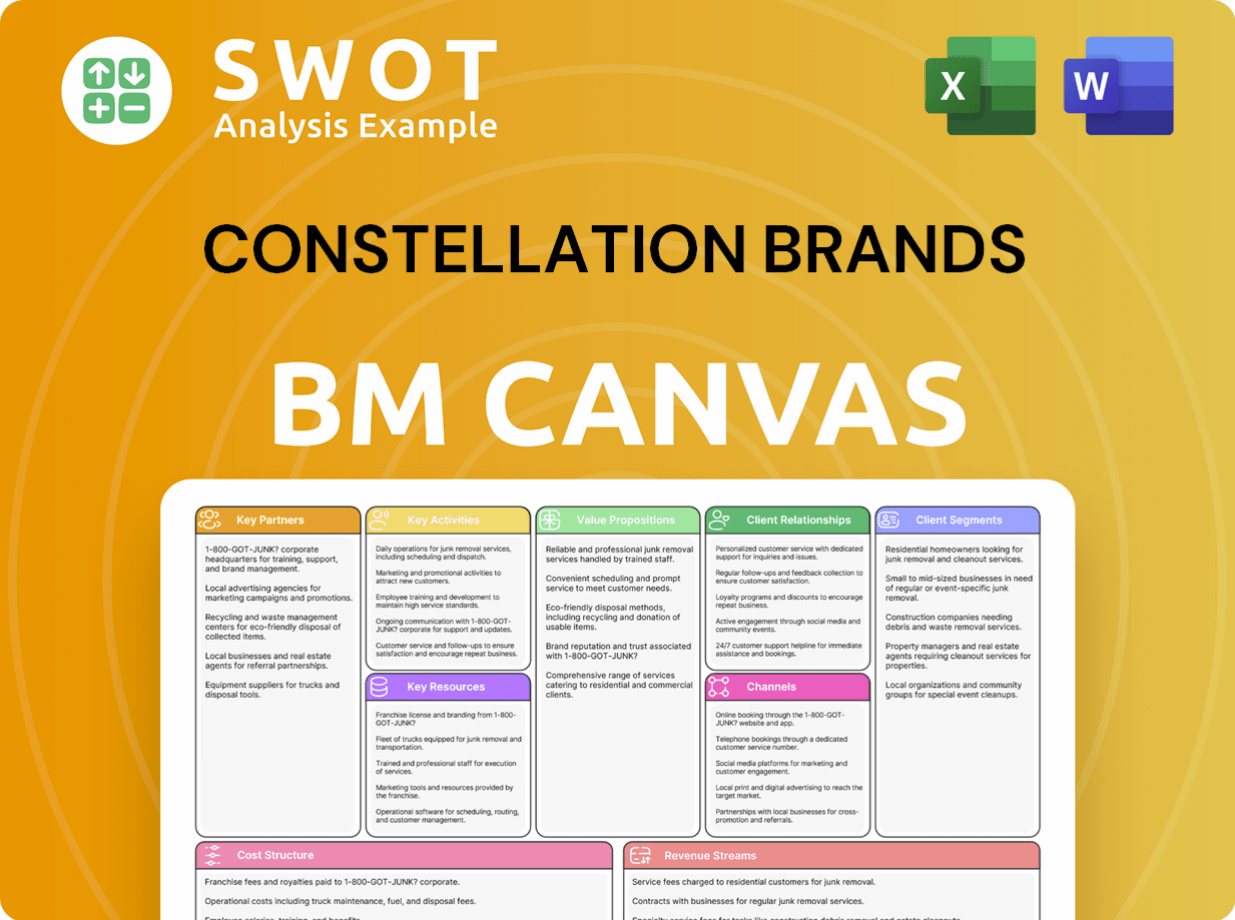Constellation Brands Bundle
Can Constellation Brands Continue Its Reign in the Alcoholic Beverage Industry?
Since its inception in 1945, Constellation Brands has transformed from a regional player into a global powerhouse in the alcoholic beverages sector. With a portfolio boasting iconic brands like Corona and Robert Mondavi, the company has consistently adapted to market dynamics. This exploration dives into the Constellation Brands SWOT Analysis, examining its growth strategy and future prospects.

Constellation Brands' strategic acquisitions, such as the Grupo Modelo's U.S. beer business, have significantly boosted its market share and revenue growth. Understanding Constellation Brands' growth strategy is key to predicting its future outlook, especially considering the evolving trends in the wine and spirits industry. This analysis provides a comprehensive market analysis, considering its brand portfolio expansion and international expansion plans, to assess its long-term investment potential and impact of economic conditions.
How Is Constellation Brands Expanding Its Reach?
Constellation Brands is actively pursuing various expansion initiatives to strengthen its market position and diversify its revenue streams. The company's growth strategy focuses on building a robust portfolio of alcoholic beverages, including beer, wine, and spirits, to cater to diverse consumer preferences. This strategy is supported by significant investments in production capacity, new product development, and strategic acquisitions, all aimed at driving long-term growth and enhancing shareholder value.
A primary focus remains on strengthening its leadership in the U.S. high-end beer market. The company plans to invest approximately $3 billion in beer production between fiscal years 2025 and 2028, primarily in Mexico, to support the anticipated future needs of its Mexican beer brands. This commitment underscores the company's confidence in the continued growth of its beer segment and its ability to capitalize on market opportunities.
The company's approach to expansion is multifaceted, encompassing capacity enhancements, new product launches, and strategic acquisitions. These initiatives are designed to capture new consumer segments and maintain a competitive edge in a rapidly evolving industry. For a deeper dive into the marketing strategies employed, consider exploring the Marketing Strategy of Constellation Brands.
Constellation Brands is significantly increasing its beer production capacity. The company is investing approximately $3 billion between fiscal years 2025 and 2028. This investment is primarily focused on its Mexican breweries.
The company is expanding its product portfolio through new product development. In fiscal year 2024, they launched products like Modelo Oro and Corona Sin Alcohol. Further launches are planned for fiscal year 2025, including Modelo Spiked Aguas Frescas.
Constellation Brands is actively pursuing strategic acquisitions to strengthen its portfolio. The recent acquisition of Sea Smoke, a luxury wine brand, is a prime example. This aligns with the premiumization trends in the market.
In fiscal year 2024, the company invested over $900 million to increase capacity. This increased capacity from approximately 42 million to 48 million hectoliters. The construction of the Veracruz Brewery is ongoing.
Constellation Brands' expansion strategy involves significant investments in beer production, particularly in Mexico, with a focus on increasing capacity. The company is also expanding its product offerings through new product launches and strategic acquisitions to capture new consumer segments and maintain a competitive edge.
- Investment of approximately $3 billion in beer production between fiscal years 2025 and 2028.
- Ongoing expansion, optimization, and construction activities at Mexican breweries.
- Targeted acquisitions, such as Sea Smoke, to align with premiumization trends.
- New product launches like Modelo Oro and Corona Sin Alcohol in fiscal year 2024.
Constellation Brands SWOT Analysis
- Complete SWOT Breakdown
- Fully Customizable
- Editable in Excel & Word
- Professional Formatting
- Investor-Ready Format

How Does Constellation Brands Invest in Innovation?
Constellation Brands (CBI) focuses on innovation and technology to foster sustained growth and enhance operational efficiency. The company is actively investing in infrastructure to support its business, including data systems and architecture. This strategic approach is crucial for maintaining a competitive edge in the dynamic alcoholic beverages market.
The company's commitment to innovation is evident in its multi-year Digital Business Acceleration initiative. This initiative is designed to improve technology capabilities across key areas. These efforts are key to understanding the future prospects of Constellation Brands.
In fiscal year 2025, the focus was on end-to-end digital supply chain planning, logistics, procurement, and revenue growth management. Plans are in place to expand this initiative to include consumer insights and analytics in fiscal year 2026, demonstrating a forward-thinking approach to business development.
The Digital Business Acceleration initiative enhances technology capabilities. It focuses on supply chain planning, logistics, procurement, and revenue growth management. This initiative is critical for optimizing operations.
Expansion to include consumer insights and analytics is planned for fiscal year 2026. This expansion will help the company better understand consumer preferences. It supports brand portfolio expansion.
Constellation Brands has set ambitious environmental targets. The company aims to reduce Scope 1 and Scope 2 Greenhouse Gas (GHG) emissions. This commitment is part of its sustainable business practices.
The company invests in renewable energy sources. Solar energy is implemented at The Prisoner Wine Company and three Ruffino facilities. Investment in wind farms is also planned.
The Nava Brewery has received TRUE Zero Waste certification (Gold Level). The company aims to attain TRUE Zero Waste to Landfill Certification in key facilities by fiscal year 2025. This supports waste reduction.
Constellation Brands is enhancing circular packaging across its portfolio. The goal is to reduce packaging weight by 10% and ensure 80% of packaging is returnable, recyclable, or renewable. This is a key aspect of its growth strategy.
In terms of sustainability, Constellation Brands has set environmental targets, aiming to reduce its Scope 1 and Scope 2 Greenhouse Gas (GHG) emissions by 15% by fiscal year 2025 from a fiscal year 2020 baseline. To achieve this, the company is optimizing energy efficiency, investing in renewable energy, and supporting green energy initiatives. For example, the implementation of solar energy technology at The Prisoner Wine Company in California and three Ruffino facilities in Italy, and plans to convert a portion of its beer operations to natural gas and invest in wind farms. The Nava Brewery has also received TRUE Zero Waste certification (Gold Level), demonstrating its commitment to waste reduction and resource efficiency. Furthermore, the company is working towards attaining TRUE Zero Waste to Landfill Certification in its key operating facilities by fiscal year 2025 and enhancing circular packaging across its portfolio. This includes plans to reduce the ratio of packaging weight to product weight by 10% across its Wine & Spirits portfolio and ensuring that 80% of packaging is returnable, recyclable, or renewable. For more details on the company's history and development, you can read the Brief History of Constellation Brands.
Constellation Brands is focused on environmental sustainability. The company is investing in renewable energy and waste reduction. These initiatives are crucial for long-term investment potential.
- Reducing GHG emissions by 15% by fiscal year 2025.
- Implementing solar energy at key facilities.
- Achieving TRUE Zero Waste to Landfill Certification by fiscal year 2025.
- Enhancing circular packaging across the portfolio.
Constellation Brands PESTLE Analysis
- Covers All 6 PESTLE Categories
- No Research Needed – Save Hours of Work
- Built by Experts, Trusted by Consultants
- Instant Download, Ready to Use
- 100% Editable, Fully Customizable

What Is Constellation Brands’s Growth Forecast?
The financial outlook for Constellation Brands, a key player in the Alcoholic Beverages industry, presents a nuanced picture for fiscal year 2025. The company's Growth Strategy is heavily influenced by its performance in the beer and wine & spirits segments. This strategic focus is crucial for understanding the company's Future Prospects and its ability to navigate market dynamics.
In September 2024, the company updated its fiscal 2025 outlook, adjusting its reported diluted net income per share (EPS) and comparable EPS guidance. These adjustments reflect the company's strategic responses to market conditions and its focus on key business areas. The company's commitment to shareholder value is evident through its share repurchase programs and financial targets.
Constellation Brands' financial strategy is designed to leverage its strengths in the beer segment while addressing challenges in wine and spirits. The company's approach to managing its portfolio and financial resources is critical for its long-term success. A review of Revenue Streams & Business Model of Constellation Brands can provide additional insights into the company's financial operations.
Constellation Brands anticipates diluted net income per share (EPS) to range from $3.05 to $7.92. The comparable EPS guidance is raised to a range of $13.60 to $13.80, indicating a double-digit growth expectation.
The company projects an enterprise net sales growth of 4% to 6% for fiscal year 2025. This growth is driven by the strong performance of the beer segment.
The beer segment is expected to see net sales growth of 6% to 8% and operating income growth of 11% to 12% in fiscal year 2025. This growth is supported by cost savings and marketing investments.
The Wine and Spirits business is facing challenges, with expected net sales declines of (6)% to (4)% and operating income declines of (18)% to (16)%. A non-cash goodwill impairment loss of approximately $1.5 billion to $2.5 billion is expected.
Constellation Brands' financial health is indicated by key metrics and strategic financial targets. The company's performance is closely monitored by investors and analysts.
- Gross profit margin for fiscal years ending February 2021 to 2025 averaged 51.9%.
- The latest twelve months gross profit margin was 52.3% as of May 20, 2025.
- The operating margin for the quarter ending February 28, 2025, was 3.49%.
- The average operating margin for 2024 was 21.81%.
- The company aims to generate between $10 billion and $12 billion in free cash flow from fiscal year 2024 to fiscal year 2028.
Constellation Brands Business Model Canvas
- Complete 9-Block Business Model Canvas
- Effortlessly Communicate Your Business Strategy
- Investor-Ready BMC Format
- 100% Editable and Customizable
- Clear and Structured Layout

What Risks Could Slow Constellation Brands’s Growth?
The future of Constellation Brands faces several potential risks and obstacles. These challenges span market dynamics, economic pressures, regulatory changes, and operational vulnerabilities. Understanding these risks is crucial for assessing the company's Growth Strategy and Future Prospects.
Market competition, particularly in the beer sector, is a significant concern. Shifting consumer preferences and economic uncertainties further complicate the landscape. The company's performance in Q1 fiscal 2025 shows declines in key brand sales, indicating potential headwinds.
Economic factors, regulatory shifts, and operational challenges pose substantial risks to Constellation Brands. These include inflation-driven margin pressures, potential tariffs, and supply chain disruptions. The company must navigate these complexities to maintain its market position and achieve its Business Development goals.
Intense competition in the Alcoholic Beverages market, especially in the beer segment, is a major risk. The company's beer division accounts for over 80% of sales, making it particularly vulnerable to market shifts. Market Analysis reveals a softening U.S. beer market and changing consumer preferences, which could impact sales volumes.
Economic factors, such as inflation and reduced consumer spending, pose a threat. Inflation can lead to margin pressures, while decreased discretionary income can affect demand for premium products. Q1 fiscal 2025 results showed declines in key brand sales, indicating vulnerability to economic downturns.
Regulatory changes and geopolitical events, like potential tariffs on Mexican imports, present significant risks. Analysts estimate that a 25% tariff could reduce earnings per share by a substantial amount. Changes in immigration policies could also affect the labor market, impacting operations.
Supply chain disruptions, including issues with water, agricultural materials, and packaging, can hinder production and distribution. These vulnerabilities can affect the company's ability to meet customer demand and maintain its market position. The company is actively working on mitigating these risks.
Technological disruptions, reliance on complex information systems, and cybersecurity threats are also acknowledged risks. The company is investing in digital capabilities to address these challenges. Furthermore, potential write-downs of intangible assets, such as goodwill, pose financial risks.
The company faces potential write-downs of intangible assets, such as goodwill and trademarks. For instance, an expected $1.5 billion to $2.5 billion goodwill impairment loss for the Wine and Spirits business in fiscal 2025 reflects negative trends in the U.S. wholesale wine market. The company is considering strategic actions, including selling its wine division.
To address these risks, the company is implementing several strategies. These include portfolio optimization, cost-cutting measures, and investments in infrastructure and digital capabilities. Management is actively monitoring and preparing for these challenges to safeguard Constellation Brands' long-term performance and Future Outlook 2024.
Recent financial reports indicate that while overall revenue has grown, key brand sales have seen declines. For example, in Q1 fiscal 2025, Modelo Especial was down 1%, Corona Extra decreased by 6%, and Modelo Chelada fell by 3%. These figures highlight the impact of market competition and changing consumer preferences. The company's financial performance review is critical.
Constellation Brands Porter's Five Forces Analysis
- Covers All 5 Competitive Forces in Detail
- Structured for Consultants, Students, and Founders
- 100% Editable in Microsoft Word & Excel
- Instant Digital Download – Use Immediately
- Compatible with Mac & PC – Fully Unlocked

Related Blogs
- What are Mission Vision & Core Values of Constellation Brands Company?
- What is Competitive Landscape of Constellation Brands Company?
- How Does Constellation Brands Company Work?
- What is Sales and Marketing Strategy of Constellation Brands Company?
- What is Brief History of Constellation Brands Company?
- Who Owns Constellation Brands Company?
- What is Customer Demographics and Target Market of Constellation Brands Company?
Disclaimer
All information, articles, and product details provided on this website are for general informational and educational purposes only. We do not claim any ownership over, nor do we intend to infringe upon, any trademarks, copyrights, logos, brand names, or other intellectual property mentioned or depicted on this site. Such intellectual property remains the property of its respective owners, and any references here are made solely for identification or informational purposes, without implying any affiliation, endorsement, or partnership.
We make no representations or warranties, express or implied, regarding the accuracy, completeness, or suitability of any content or products presented. Nothing on this website should be construed as legal, tax, investment, financial, medical, or other professional advice. In addition, no part of this site—including articles or product references—constitutes a solicitation, recommendation, endorsement, advertisement, or offer to buy or sell any securities, franchises, or other financial instruments, particularly in jurisdictions where such activity would be unlawful.
All content is of a general nature and may not address the specific circumstances of any individual or entity. It is not a substitute for professional advice or services. Any actions you take based on the information provided here are strictly at your own risk. You accept full responsibility for any decisions or outcomes arising from your use of this website and agree to release us from any liability in connection with your use of, or reliance upon, the content or products found herein.